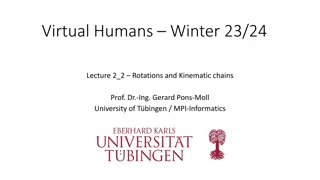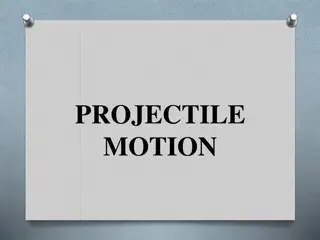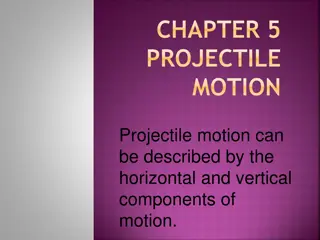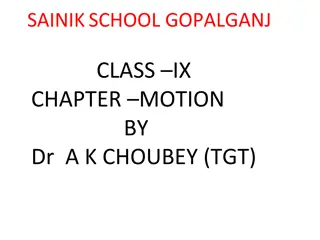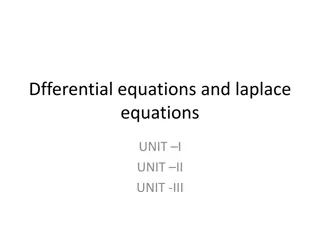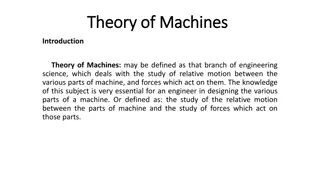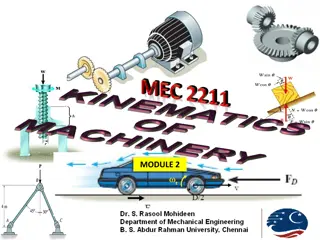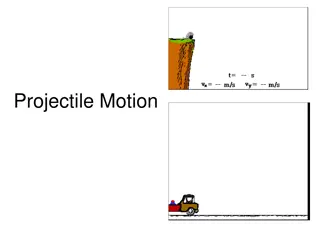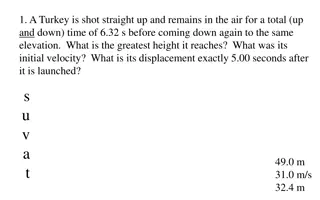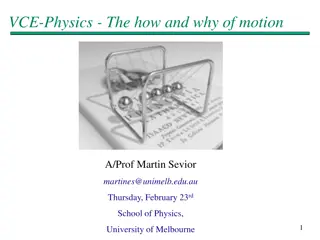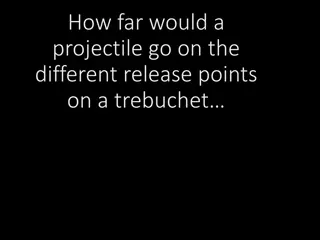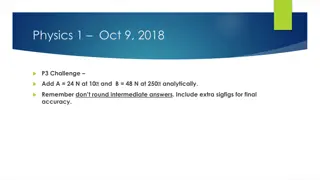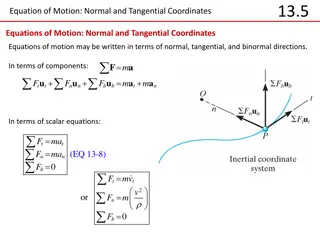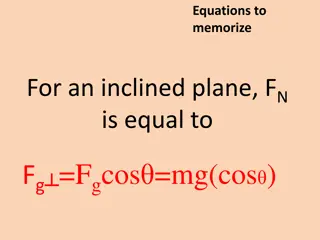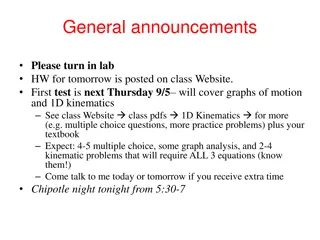2D Kinematic Equations of Motion and Projectile Motion
In this lecture on June 11, 2014, Dr. JaeJaehoon Yu delves into the realm of 2-dimensional motion, discussing the fundamentals of projectile motion and the application of 2D kinematic equations. This session of PHYS.1441-001, Summer 2014, is a deep dive into the intricacies of motion in two dimensions, exploring the dynamics and calculations involved in understanding the pathways of projectiles.
Download Presentation

Please find below an Image/Link to download the presentation.
The content on the website is provided AS IS for your information and personal use only. It may not be sold, licensed, or shared on other websites without obtaining consent from the author.If you encounter any issues during the download, it is possible that the publisher has removed the file from their server.
You are allowed to download the files provided on this website for personal or commercial use, subject to the condition that they are used lawfully. All files are the property of their respective owners.
The content on the website is provided AS IS for your information and personal use only. It may not be sold, licensed, or shared on other websites without obtaining consent from the author.
E N D
Presentation Transcript
PHYS 1441 Section 001 Lecture #6 Wednesday, June 11, 2014 Dr. Jae Jaehoon Yu Yu Understanding the 2 Dimensional Motion 2D Kinematic Equations of Motion Projectile Motion Wednesday, June 11, 2014 PHYS 1441-001, Summer 2014 Dr. Jaehoon Yu 1
Announcements Reading Assignment CH3.7 Quiz #2 Beginning of the class tomorrow, Thursday, June, 12 Covers CH3.1 to what we finish today, Wednesday, June 11 Bring your calculator but DO NOT input formula into it! Your phones or portable computers are NOT allowed as a replacement! You can prepare a one 8.5x11.5 sheet (front and back) of handwritten formulae and values of constants for the exam no solutions, derivations or definitions! No additional formulae or values of constants will be provided! 1st Term exam results Class average: 61.2/99 Equivalent to 61.8/100 Top score: 99/99 Wednesday, June 11, 2014 Dr. Jaehoon Yu PHYS 1441-001, Summer 2014 2
Reminder: Special Project #2 Show that the trajectory of a projectile motion is a parabola!! 20 points Due: Monday, June 16 You MUST show full details of your OWN computations to obtain any credit Beyond what was covered in this lecture note and in the book! Wednesday, June 11, 2014 PHYS 1441-001, Summer 2014 Dr. Jaehoon Yu 3
A Motion in 2 Dimension This is a motion that could be viewed as two motions combined into one. (superposition ) Wednesday, June 11, 2014 PHYS 1441-001, Summer 2014 Dr. Jaehoon Yu 4
Motion in horizontal direction (x) ( )t vx= vxo+ axt vx x =1 x = vxot +1 2vxo+vx 2= vxo 2+ 2axx 2axt2 Wednesday, June 11, 2014 PHYS 1441-001, Summer 2014 Dr. Jaehoon Yu 5
Motion in vertical direction (y) vy= vyo+ ayt ( )t y =1 vy 2vyo+ vy 2= vyo 2+ 2ayy y = vyot +1 2ayt2 Wednesday, June 11, 2014 PHYS 1441-001, Summer 2014 Dr. Jaehoon Yu 6
A Motion in 2 Dimension Imagine you add the two 1 dimensional motions on the left. It would make up a one 2 dimensional motion on the right. Wednesday, June 11, 2014 PHYS 1441-001, Summer 2014 Dr. Jaehoon Yu 7
Kinematic Equations in 2-Dim y-component x-component vx= vxo+ axt vy= vyo+ ayt ( )t ( )t y =1 vy 2vyo+ vy x =1 vx 2vxo+vx 2= vyo 2+ 2ayy 2= vxo 2+ 2axx Dy = vyot +1 2ayt2 Dx = vxot +1 2axt2 Wednesday, June 11, 2014 PHYS 1441-001, Summer 2014 Dr. Jaehoon Yu 8
Ex. A Moving Spacecraft In the x direction, the spacecraft in zero-gravity zone has an initial velocity component of +22 m/s and an acceleration of +24 m/s2. In the y direction, the analogous quantities are +14 m/s and an acceleration of +12 m/s2. Find (a) x and vx, (b) y and vy, and (c) the final velocity of the spacecraft at time 7.0 s. Wednesday, June 11, 2014 PHYS 1441-001, Summer 2014 Dr. Jaehoon Yu 9
How do we solve this problem? 1. Visualize the problem Draw a picture! 2. Decide which directions are to be called positive (+) and negative (-). Normal convention is the right-hand rule. 3. Write down the values that are given for any of the five kinematic variables associated with each direction. 4. Verify that the information contains values for at least three of the kinematic variables. Do this for x and y separately. Select the appropriate equation. 5. When the motion is divided into segments, remember that the final velocity of one segment is the initial velocity for the next. 6. Keep in mind that there may be two possible answers to a kinematics problem. Wednesday, June 11, 2014 PHYS 1441-001, Summer 2014 Dr. Jaehoon Yu 10
Ex. continued In the x direction, the spacecraft in a zero gravity zone has an initial velocity component of +22 m/s and an acceleration of +24 m/s2. In the y direction, the analogous quantities are +14 m/s and an acceleration of +12 m/s2. Find (a) x and vx, (b) y and vy, and (c) the final velocity of the spacecraft at time 7.0 s. x ax vx ? vox t +24.0 m/s2 +22.0 m/s ? 7.0 s y ay vy ? voy t ? +12.0 m/s2 +14.0 m/s 7.0 s Wednesday, June 11, 2014 PHYS 1441-001, Summer 2014 Dr. Jaehoon Yu 11
First, the motion in x-direciton x ax vx ? vox t ? +24.0 m/s2 +22 m/s 7.0 s voxt +1 ( 2axt2 ) 7.0 s Dx = = 22m s vox+axt = 22m s ( )7.0 s ( )+1 ( ) 2= +740 m 224m s2 vx= ( )7.0 s ( )+ 24m s2 ( )= +190m s Wednesday, June 11, 2014 PHYS 1441-001, Summer 2014 Dr. Jaehoon Yu 12
Now, the motion in y-direction y ay vy ? voy t ? +12.0 m/s2 +14 m/s 7.0 s voyt +1 2ayt2 ) 7.0 s Dy = = 14m s ( )7.0 s ( ( )+1 ( ) 2= +390 m 212m s2 voy+ ayt yv = = 14m s ( )7.0 s ( )+ 12m s2 ( )= +98m s Wednesday, June 11, 2014 PHYS 1441-001, Summer 2014 Dr. Jaehoon Yu 13
The final velocity v vy= 98m s q vx=190m s ) tan-198 190 Yes, you are right! Using components and unit vectors!! 190m s ( ( 2+ 98m s ( )= 27 ) 2= 210m s A vector can be fully described when the magnitude and the direction are given. Any other way to describe it? v = q = m s Wednesday, June 11, 2014 PHYS 1441-001, Summer 2014 Dr. Jaehoon Yu 14
If we visualize the motion Wednesday, June 11, 2014 PHYS 1441-001, Summer 2014 Dr. Jaehoon Yu 15
What is the Projectile Motion? A 2-dim motion of an object under the gravitational acceleration with the following assumptions Free fall acceleration, g g, is constant over the range of the motion and Air resistance and other effects are negligible A motion under constant acceleration!!!! Superposition of two motions Horizontal motion with constant velocity ( no acceleration ) Vertical motion under constant acceleration ( g g ) vyf= ( ) m s2 ay= ax= -9.8m s2 0m s2 vxf= vx0 ( )t vy0+ ayt = vy0+ -9.8 Wednesday, June 11, 2014 16 PHYS 1441-001, Summer 2014 Dr. Jaehoon Yu
Projectile Motion But the object is still moving!! Why? Because it still has constant velocity in horizontal direction!! Why? Because there is no acceleration in horizontal direction!! Maximum height The only acceleration in this Wednesday, June 11, 2014 PHYS 1441-001, Summer 2014 Dr. Jaehoon Yu motion. It is a constant!! 17
Kinematic Equations for a projectile motion y-component - g =-9.8m s2 x-component ax= ay= 0 vy= vyo- gt vx= vxo ( )t Dy =1 vy 2vyo+ vy 2= vyo Dx = vxot vx0 2- 2gy 2= vxo 2 Dy = vyot -1 2gt2 Dx = vxot Wednesday, June 11, 2014 PHYS 1441-001, Summer 2014 Dr. Jaehoon Yu 18
Show that a projectile motion is a parabola!!! vxi= visinqi vicosqi vyi= x-component y-component In a projectile motion, the only acceleration is gravitational one whose direction is always toward the center of the earth (downward). axi + ayj =-gj a = xf t = xf= vxit = vicosqit ax=0 vicosqi = visinqit -1 yf= vyit +1 ( )t2 2gt2 2-g 2 xf xf -1 Plug t into the above yf= visinqi 2g vicosqi vicosqi xf g yf= xftanqi- 2 What kind of parabola is this? 2cos2qi 2vi Wednesday, June 11, 2014 PHYS 1441-001, Summer 2014 Dr. Jaehoon Yu 19
Example for a Projectile Motion A ball is thrown with an initial velocity v=(20i+40j)m/s. Estimate the time of flight and the distance from the original position when the ball lands. Which component determines the flight time and the distance? 40t +1 ( )t2=0m yf= t 80- gt So the possible solutions are -g 2 Flight time is determined by the y component, because the ball stops moving when it is on the ground after the flight. ( )= 0 \t = 0 or t =80 8sec g Distance is determined by the x component in 2-dim, because the ball is at y=0 position when it completed it s flight. \t 8sec Why isn t 0 the solution? vxit =20 8=160 m ( ) xf= Wednesday, June 11, 2014 PHYS 1441-001, Summer 2014 Dr. Jaehoon Yu 20
Ex.3.5 The Height of a Kickoff A placekicker kicks a football at an angle of 40.0 degrees and the initial speed of the ball is 22 m/s. Ignoring air resistance, determine the maximum height that the ball attains. Wednesday, June 11, 2014 PHYS 1441-001, Summer 2014 Dr. Jaehoon Yu 21
First, the initial velocity components v0= 22m s v0 y q = 40 v0x ( ( )cos40 = 17m s )sin40 = 14m s ov cosq = 22m s ov sinq = 22m s v0x= v0y= Wednesday, June 11, 2014 PHYS 1441-001, Summer 2014 Dr. Jaehoon Yu 22
Motion in y-direction is of the interest.. y ay vy v0y t ? -9.8 m/s2 0 m/s +14 m/s Wednesday, June 11, 2014 PHYS 1441-001, Summer 2014 Dr. Jaehoon Yu 23
Now the nitty, gritty calculations y ? ay vy 0 v0y 14 m/s t -9.80 m/s2 What happens at the maximum height? The ball s velocity in y-direction becomes 0!! Because there is no acceleration in x- direction!! And the ball s velocity in x-direction?Stays the same!! Why? Which kinematic formula would you like to use? voy 2- voy 2ay 2 vy 2+ 2ayy yv = 2 y = Solve for y ( 2 -9.8m s2 ( ) 2 ) 0- 14m s y = = +10 m Wednesday, June 11, 2014 PHYS 1441-001, Summer 2014 Dr. Jaehoon Yu 24
Ex.3.9 extended: The Time of Flight of a Kickoff What is the time of flight between kickoff and landing? Wednesday, June 11, 2014 PHYS 1441-001, Summer 2014 Dr. Jaehoon Yu 25
What is y when it reached the max range? y ay vy voy t ? 0 m -9.80 m/s2 14 m/s Wednesday, June 11, 2014 PHYS 1441-001, Summer 2014 Dr. Jaehoon Yu 26
Now solve the kinematic equations in y direction!! y ay vy voy 14 m/s t 0 -9.80 m/s2 ? ( ) y = voyt +1 2ayt2 0 = voyt +1 2ayt2= t voy+1 2ayt Since y=0 t = 0 or Two soultions -voy 1 2ay -2voy ay =-2 14 -9.8 = 2.9s = voy+1 2ayt = 0 t = Solve for t Wednesday, June 11, 2014 PHYS 1441-001, Summer 2014 Dr. Jaehoon Yu 27
Ex.3.9 The Range of a Kickoff Calculate the range R of the projectile. ( ) 2.9 s ( )= +49 m voxt +1 2axt2= voxt = 17m s x = Wednesday, June 11, 2014 PHYS 1441-001, Summer 2014 Dr. Jaehoon Yu 28




